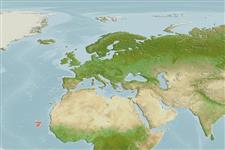Common names from other countries
Classification / Names
Nomi Comuni | Sinonimi | Catalog of Fishes(Genere, Specie) | ITIS | CoL | WoRMS | Cloffa
>
Blenniiformes (Blennies) >
Labrisomidae (Labrisomids)
Etymology: Malacoctenus: Greek, malakos = soft + Greek, kteis, ktenos = comb (Ref. 45335); carrowi: Named for Frank Carrow, Carrow Foundation..
Environment: milieu / climate zone / depth range / distribution range
Ecologia
marino associati a barriera corallina; distribuzione batimetrica 11 - 13 m (Ref. 98055). Tropical
Eastern Central Atlantic: Cape Verde Islands.
Size / Peso / Age
Maturity: Lm ? range ? - ? cm
Max length : 3.5 cm SL maschio/sesso non determinato; (Ref. 98055); 3.2 cm SL (female)
Short description
Chiavi di identificazione | Morfologia | Morfometria
Spine dorsali (totale) : 20; Raggi dorsali molli (totale) : 10; Spine anali: 2; Raggi anali molli: 19. This species is distinguished by the following characters: D XX+10; A II+19; pectoral 14 soft rays; ventrals three soft rays; the length of shortest pelvic ray is more than half the length of the longest pelvic ray; lateral line scales 55-56; presence of prepectoral scales which are considerably smaller than scales on body; belly scaled except breast area; colour pattern dominated by 6 vertical bars on the body, delineated in straight vertical lines; these bands barely enter the dorsal fin; transparent dorsal fin membranes (Ref. 98055).
Collected using anaesthetic (quinaldine or clove) oil sprayed into horizontal cracks in rock faces or below large stones at about 10-13 m depth. Additional animals were seen when overturning big stones at 10-16 m and one individual was photographed at night, resting on open rock in water only 3 m deep (Ref. 98055).
Life cycle and mating behavior
Maturities | Riproduzione | Spawnings | Egg(s) | Fecundities | Larve
Wirtz, P., 2014. A new species of Malacoctenus from the Cape Verde Islands, eastern Atlantic (Pisces Teleostei, Labrisomidae). Arquipelago. Life and Marine Sciences 31:15-20. (Ref. 98055)
IUCN Red List Status (Ref. 130435)
CITES (Ref. 128078)
Not Evaluated
Threat to humans
Harmless
Human uses
Strumenti
Special reports
Download XML
Fonti Internet
Estimates based on models
Preferred temperature (Ref.
115969): 23.9 - 25, mean 24.4 (based on 17 cells).
Phylogenetic diversity index (Ref.
82804): PD
50 = 0.5000 [Uniqueness, from 0.5 = low to 2.0 = high].
Bayesian length-weight: a=0.00912 (0.00399 - 0.02083), b=3.06 (2.87 - 3.25), in cm Total Length, based on LWR estimates for this (Sub)family-body shape (Ref.
93245).
Trophic level (Ref.
69278): 3.3 ±0.4 se; based on size and trophs of closest relatives
Fishing Vulnerability (Ref.
59153): Low vulnerability (10 of 100).
